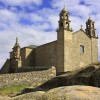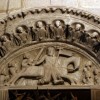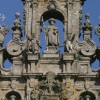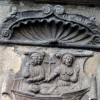- Accede I
- Regístrate I
- carrito
Santiago en Hispania
Según cuenta la tradición, cuando los Apóstoles marcharon a predicar las enseñanzas de Jesús por el mundo, Santiago encaminó sus pasos a Hispania. El Breviarium Apostolorum del s. VI, y los textos de San Isidoro en el s.VII y del Beato de Liébana cien años más tarde, sitúan a Santiago en distintos puntos de la Península Ibérica como evangelizador.
Los relatos más conocidos son los que refieren las visitas que recibió de la Virgen en Zaragoza y en Muxía para reconfortarlo cuando su ánimo decaía. La aparición en Zaragoza tuvo lugar aún en vida de la Virgen, cuando habitaba con el Apóstol Juan en Éfeso y, tal como cuenta la historia, María se le apareció sobre un pilar, dando así lugar a la advocación de la Virgen del Pilar. Por otro lado, la aparición mariana en Muxía mezcla elementos cristianos y precristianos: cuenta esta leyenda que cuando Santiago se hallaba predicando por el noroeste peninsular, se angustió por el poco éxito de su misión evangelizadora. Mientras oraba a la orilla del mar vio aparecer una embarcación de piedra, gobernada por dos ángeles, en la que viajaba María. La Virgen lo animó a continuar su labor y le entregó una imagen suya, para la que Santiago levantó un pequeño altar debajo de una roca.
Muchos años después, las gentes del lugar encontraron la imagen y construyeron allí mismo un santuario, la Iglesia de Nuestra Señora de la Barca, a la que cada septiembre acuden numerosos romeros. La barca de piedra quedó en la orilla y a sus piezas (tres piedras que representan la barca, la vela y el timón) se les atribuyen diversas propiedades milagrosas.

















